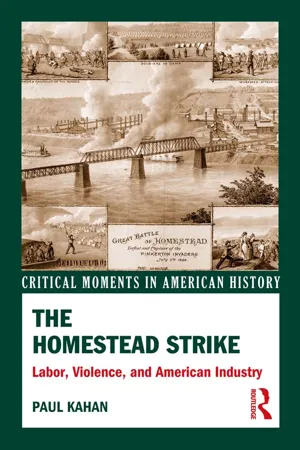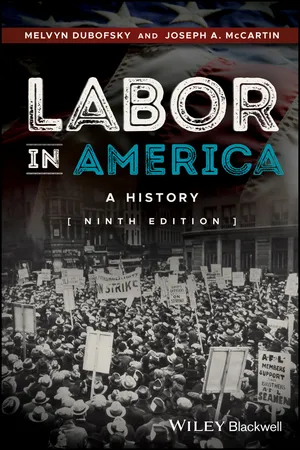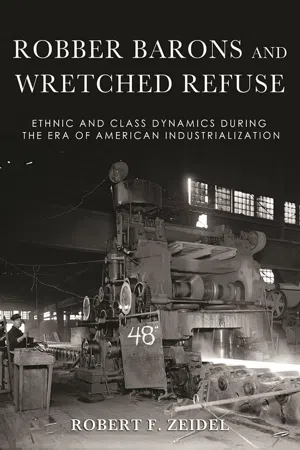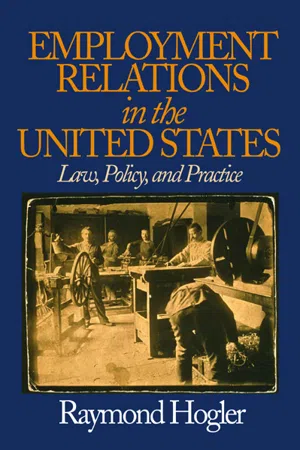History
Homestead Strike 1892
The Homestead Strike of 1892 was a major labor dispute at the Homestead Steel Works in Pennsylvania. It was sparked by a wage cut and led to a violent confrontation between the steelworkers and the Pinkerton detectives hired by the company. The strike ultimately resulted in a significant setback for the labor movement and highlighted the tensions between workers and management during the Industrial Revolution.
Written by Perlego with AI-assistance
Related key terms
5 Key excerpts on "Homestead Strike 1892"
- eBook - ePub
The Homestead Strike
Labor, Violence, and American Industry
- Paul Kahan(Author)
- 2014(Publication Date)
- Routledge(Publisher)
CHAPTER 3 Lead-up to the Strike P eople tend to think of the events at Homestead as a single, discrete episode in the history of American labor relations. In reality, as the last chapter demonstrated, the violence that rocked Homestead in July 1892 was the culmination of a series of changes reshaping American industry and society at the end of the nineteenth century. On the one hand (as shown in Chapter 1), individual personalities were crucial to the way events at Homestead unfolded; remove either Carnegie or Frick from the mix, and things might have turned out very differently. On the other hand, individual actors make choices in a very specific context that limits their options and makes certain outcomes likelier than others. It is crucial, therefore, to understand the context that gave rise to the events at Homestead and to see what happened there not as a single event, but rather an episode in a larger struggle between labor and industry that (as the last chapter described) had been taking place for years. The last 30 years of the nineteenth century was a period of great transition and uncertainty for business and labor alike. The United States was rocked by three recessions during this period (1873–1877, 1883–1885, and 1893–1897), resulting in extensive business failures and prolonged periods of unemployment. 1 Until the 1930s, historians called this period “the Great Depression” because the years of economic contraction actually exceeded those of expansion. This was America’s “Gilded Age,” a period of population growth and accumulation of wealth on a scale larger than at any time in American history up to that point. While the well connected could get outrageously wealthy, often their success came at the expense of millions of other people who lived on the very edge of abject poverty - eBook - ePub
The Long Gilded Age
American Capitalism and the Lessons of a New World Order
- Leon Fink(Author)
- 2014(Publication Date)
- University of Pennsylvania Press(Publisher)
36 Once the militia, bivouacked on company property and prepared to reopen the works at the company’s bidding, intervened, the confrontation was over.It is worth noting that unlike many other American industrial disputes, Homestead was not a case of a fatally divided or poorly led workforce. Though hierarchies of skill, ethnicity (especially Old Immigrant versus East European), and race (African Americans in significant numbers first arrived at Homestead only in the aftermath of the 1892 strike) certainly existed within both the union and local community, a remarkable cross-ethnic (and cross-gender) solidarity had held up throughout the siege. Yet, everything changed with the arrival of the militia. Chicago’s Arbeiter-Zeitung compared the situation unfavorably to Bismarck’s threatened use of force against the Ruhr miners. As a self-identified “Homesteader” rhetorically asked in its German-language pages, “What is the difference between the state’s soldiers and the Pinkertons?” 37The second (and often concurrent) resort of employers for help from the state was to the courts. In this case, Carnegie Steel’s chief counsel, Philander C. Knox, who would later serve the federal government as attorney general and secretary of state, proved a zealous litigant. As historian Paul Krause summarizes, “many of the Homestead workers, unable to raise sufficient funds for bail, were incarcerated for extended periods, and a number of those who had helped lead the sympathy strike at Duquesne also received prison sentences.” In a more controversial move, Knox collaborated with Chief Justice Edward Paxson of the Pennsylvania Supreme Court to charge thirty-three members of the Advisory Committee with no less than a charge of treason, based on a Civil War-era statute aimed at discouraging those who would attack the state. Though the treason indictments were ultimately withdrawn, the union’s resources and a good bit of its public legitimacy had been shattered by the legal onslaught. 38 - eBook - ePub
Labor in America
A History
- Melvyn Dubofsky, Joseph A. McCartin(Authors)
- 2017(Publication Date)
- Wiley-Blackwell(Publisher)
In such turbulent times, it was no wonder that conventional politics seemed to be turned upside down. A Democratic administration had been in power when depression struck. Little wonder that in 1894, in congressional elections, state gubernatorial elections, and local contests everywhere outside the Democratic South, voters ousted Democrats and replaced them with Republicans. Even in the South, the Populist uprising that united poor white farmers with wage workers and that at first sought to attract African American sharecroppers, tenants, and laborers threatened Democratic supremacy. The Populist Party, whose strength was concentrated in the South, where economic suffering was greatest, and in the plains and the mountain states, where party loyalties remained fluid, appeared to have achieved the unlikely feat of uniting farmers and workers in a potent national political movement. Unlike earlier third-party movements that had retained their independence only to fade into obscurity, the Populists chose to unite with insurgent Democrats in 1896 who had taken over their party at its turbulent 1896 convention by nominating William Jennings Bryan as its presidential candidate. Bryan, the “great commoner,” claimed to speak for the nation's farmers and workers and to condemn the greed of bankers and industrialists – do not “crucify mankind on a cross of gold,” he declaimed. So great did the threat of the Populists allied with a transformed Democratic Party appear that conservatives, including so-called “Gold Democrats,” everywhere rallied behind Bryan's opponents. In the South, conservative Democrats used racism and violence to crush their Populist and more radical Democratic adversaries. Republican victory in the election of 1896 and the nearly simultaneous end of the economic depression brought a respite from political, social, and economic turmoil, but not before a wave of industrial conflict afflicted the nation.Worker Resistance and Industrial Conflict
In the early morning of July 6, 1892, two barges were being towed slowly up the Monongahela River toward Homestead, Pennsylvania. There had been trouble at the local plant of the Carnegie Steel Company. The skilled workers at Homestead, members of the Amalgamated Association of Iron, Steel and Tin Workers (AA), had refused to accept new wage cuts and were supported in their stand by the rest of the labor force. The company's general manager, the tough-minded, stubbornly antilabor Henry Clay Frick, thereupon peremptorily shut down the entire plant and refused any further negotiations with the union. Special deputy sheriffs had been sworn in to guard company property, which was enclosed by a high boarded fence topped with barbed wire, but the locked-out workers had run the deputies out of town in the conviction that these preparations foreshadowed the use of strikebreakers. It was a challenge to his authority that Frick was only too glad to accept. Here was his chance to crush the AA once and for all. Aboard the two barges being towed up the Monongahela were three hundred Pinkerton detectives armed with Winchester rifles.As the steel company's private army drew alongside the Homestead mills and prepared to land, there was a sudden exchange of shots between the barges and the shore. The workers had entrenched themselves behind a barricade of steel billets and, as the Pinkertons tried to take possession of the plant they were beaten back in a raging battle that swirled along the riverfront. All that day, from four in the morning until five in the afternoon, the fusillade of shots continued. The strikers set up a small brass cannon behind a breastwork of railroad ties and opened fire on the barges. Failing to sink the vessels, they poured barrels of oil into the river and set the oil afire. With three of their men already dead and many more wounded, the Pinkertons were trapped. Deserted by the tug that had towed them upstream and helplessly crowded onto the barge lying farthest from the shore, they finally ran up a white flag and agreed to surrender. In return for a guarantee of safe conduct out of the community, they gave up their arms and ammunition. - eBook - ePub
Robber Barons and Wretched Refuse
Ethnic and Class Dynamics during the Era of American Industrialization
- Robert F. Zeidel(Author)
- 0(Publication Date)
- Northern Illinois University Press(Publisher)
Americans instead continued to witness intense and frequently violent class struggles, and as the new century opened, immigrants remained at the forefront of discussions as to how best to alleviate social unrest. During the Homestead strike, the United Brewers Association had voiced its support for the steelworkers in their “resistance to capitalists, some of whom are aliens, who try to contemptuously ignore the constitution [ sic ] of the United States.” 52 The alien reference likely referred to Carnegie, but it would be working-class immigrants whom most Americans would continue to see as acting in a contemptuous manner. - eBook - ePub
Employment Relations in the United States
Law, Policy, and Practice
- Raymond L. (Louis) Hogler(Author)
- 2003(Publication Date)
- SAGE Publications, Inc(Publisher)
Altgeld pardoned the remaining defendants, stating that Gary had exhibited bias and prejudice against the defendants and denied them a fair trial. Moreover, Altgeld said that much of the evidence was “a pure fabrication” and that the police had suborned the testimony of many witnesses. Declaring the defendants innocent, Altgeld in his statement “showed that the court, the prosecution, and the jury had yielded to the hysteria promoted by the press and the police, and that the entire machinery of justice had been perverted to grossly unjust ends.” 51 One outcome of the Haymarket affair was to deal a serious blow to the radical impulse within the labor movement. Powderly condemned the acts of violence and sought to dissociate the Knights of Labor from any connection with the anarchosyndicalists. Gompers, although personally more sympathetic to the defendants, deplored the teachings of the anarchists. Public opinion virulently denounced the “foreigners” who brought such alien ideas to the United States. When Altgeld issued the pardons, he was also strongly criticized in the press. Consequently, Haymarket brought radical ideas into disrepute for years, and it demonstrated the power of the media to influence public issues about labor. The Homestead Steel Strike, 1892 In contrast to Haymarket, the Homestead strike was confined to a single employer, involved primarily skilled craft workers, and focused strictly on jobrelated issues. But it, too, ended in defeat for labor. The implications of Homestead have to do with the changing nature of workplace control, the power of capital to crush even a strong union, and the consequences of such defeats for labor. By 1892, Andrew Carnegie had established his dominance in the steel industry. The Homestead Works, located near Pittsburgh on the Monongahela River, was the centerpiece of Carnegie’s empire. It employed some 3,800 workers under the immediate control of general manager Henry Clay Frick
Learn about this page
Index pages curate the most relevant extracts from our library of academic textbooks. They’ve been created using an in-house natural language model (NLM), each adding context and meaning to key research topics.




